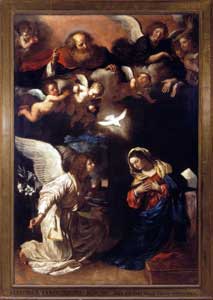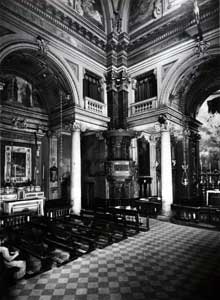
|

|
|---|---|
|
Francesco Barbieri da Cento the Guercino Annunciation, 1639 |
View of B.V. Annunciata church in a photo in the late 30’s |
The Church of the Annunciation was built in 1637 by the architects
Giovanni Battista Pessina, Francesco Maria Ricchini and Fabio Mangone, when,
thanks to a donation, it was possible to expand the Carcano Ca’ Granda.
The building has a square plan and is covered by a dome supported by eight
columns and choruses on the first floor. The painter Francesco Barbieri da
Cento known as “Il Guercino” made a painting of the Annunciation for the altar,
completed in 1639 and still on site. In the nineteenth century the building was subject
to a number of changes including the addition of an apse, and stained glass, made by Henry
and Louis Pogliaghi Crespi, and Buzzi of the Cross of Frederick. During the air raids in August
of 1943 the building was badly affected such as the internal aspect which was changed by the abilitation
during the restauration after the second world war.
In the church there’s a large crypt with frescoes made by the painter Volpino in 1637, of which
decorations unfortunately remained only a few traces. At a still lower plane than the crypt, we have
the burial ground, used to bury the remains of deceased patients in the hospital until the end of the
seventeenth century. The burial chambers were then restored during the 1848 “Five Days of Milan” to bury
the dead in battle, because, due to the state of siege, it was not possible to reach the suburban
cemeteries. It became a place of celebration of the Milanese patriots, and in 1860 was largely adapted
and transformed into a mausoleum city (the walls are still visible names of the dead and memorial inscriptions). In
1895 the remains of those killed were transferred to the new monument made by Giuseppe Grandi.
The church is still the seat of the autonomous parish hospital, which holds the Archbishop of Milan, and
houses the university chaplaincy.
The knowledge gained from an extensive campaign-finding and diagnostics for the structure
and environment of Ca’ Granda, are disclosed in the illustrated
book - Il cuore dell'antico
Ospedale Maggiore di Milano. I luoghi dell'Archivio e la Chiesa della Beata Vergine Annunciata.

 Versione italiana
Versione italiana